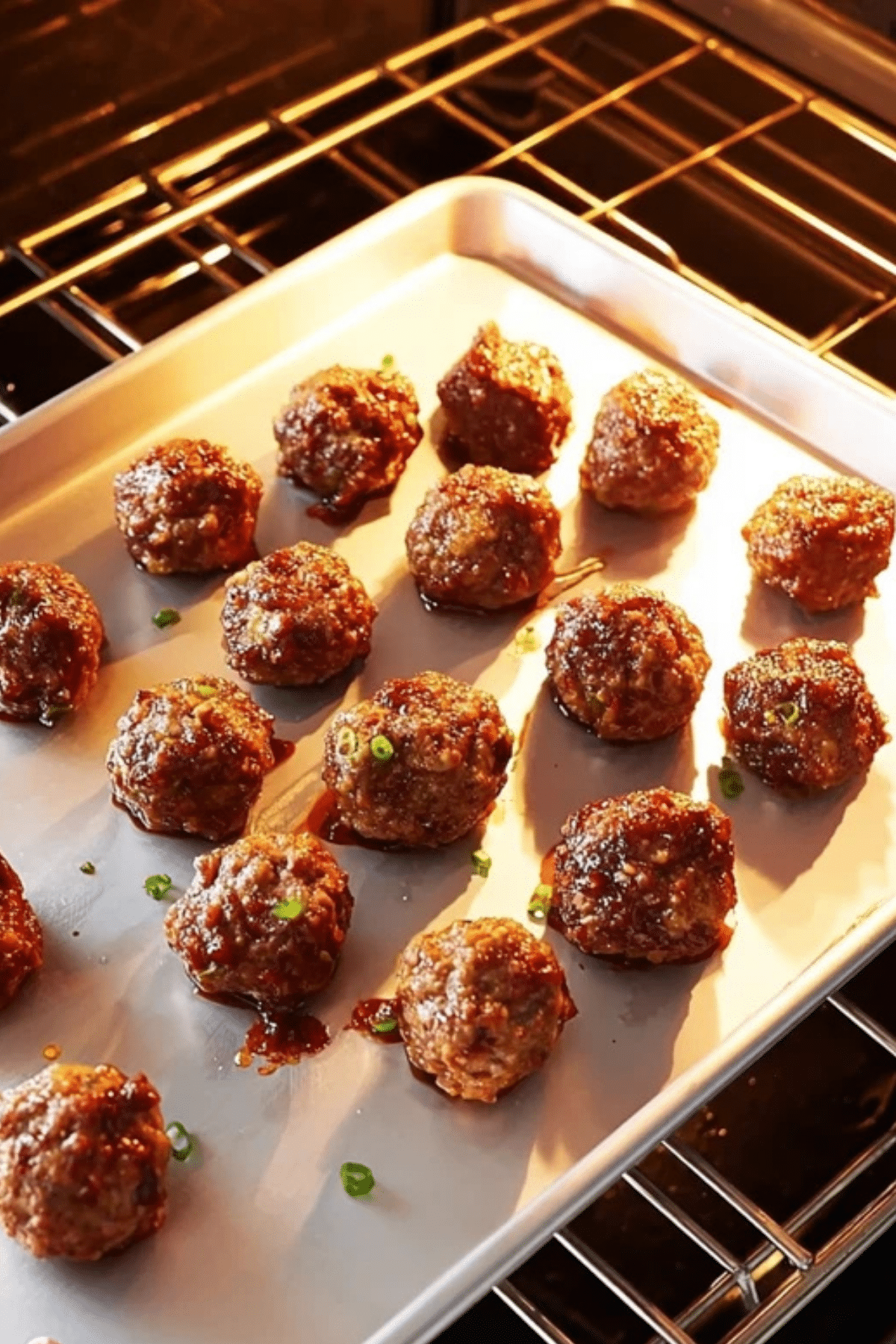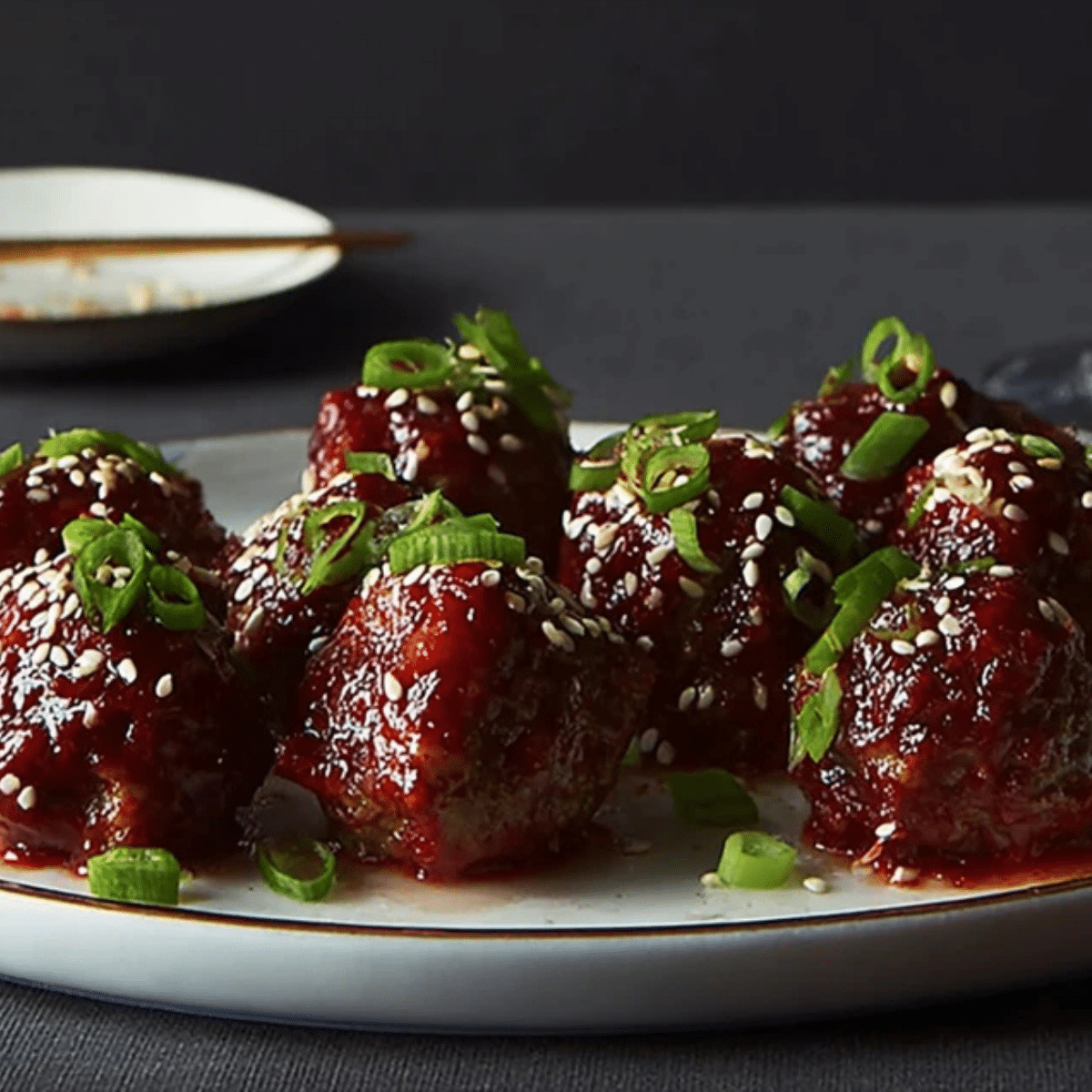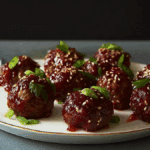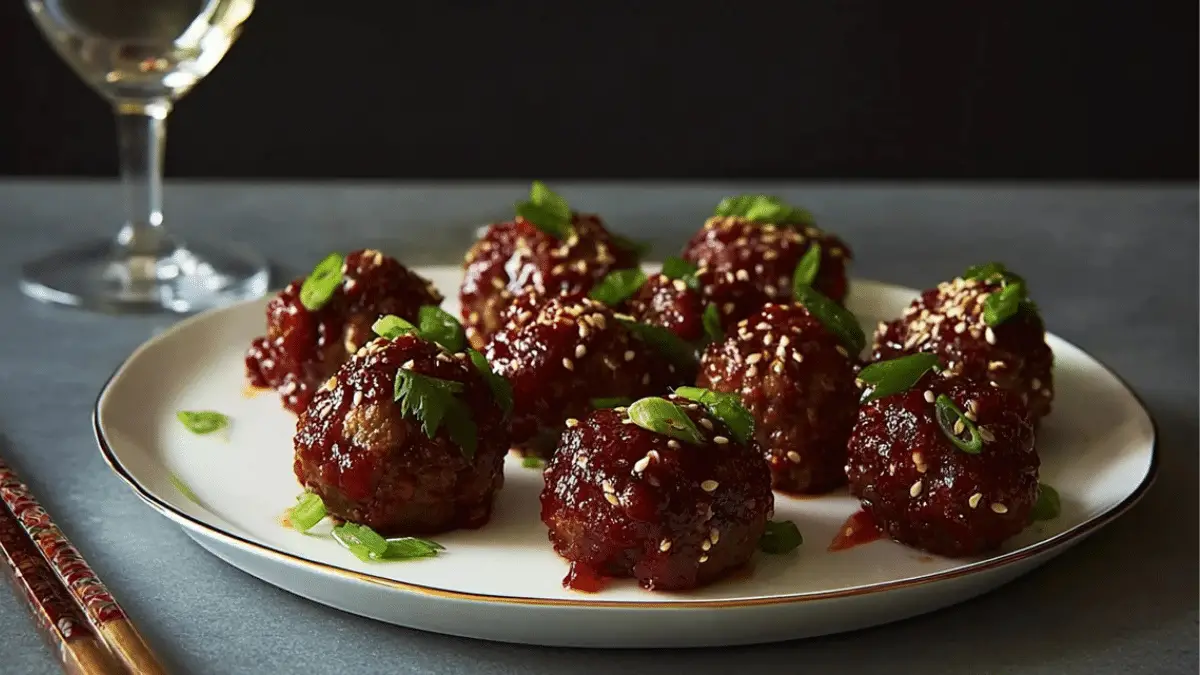Spicy Korean-Style Gochujang Meatballs are a flavorful and irresistible dish that adds a spicy, smoky twist to your classic meatball recipe. Combining the rich depth of gochujang with juicy meatballs, this recipe delivers the perfect balance of heat and savory flavors. Perfect as an appetizer for gatherings or a main dish served with rice, these meatballs are sure to be a hit with everyone at your table.
Table of Contents
What Makes Spicy Korean-Style Gochujang Meatballs Special?
Spicy Korean-Style Gochujang Meatballs are more than just a simple appetizer—they pack a punch with their bold, smoky, and slightly sweet flavors. Made with gochujang, a Korean fermented chili paste, these meatballs bring an exciting heat that complements the savory depth of ground beef. The easy-to-follow recipe ensures that you’ll have delicious meatballs in no time, with minimal prep. Whether you’re making them for a party, a family meal, or a special occasion, these meatballs never fail to impress.
Ingredients for Spicy Korean-Style Gochujang Meatballs
For the meatballs:
• Ground Beef: Provides the hearty base and meaty texture for the dish.
• Large Egg: Helps bind the meatball mixture together, ensuring a tender result.
• Scallions: Adds a fresh, mild onion flavor with a subtle crunch.
• Garlic: Offers a sharp, aromatic kick to enhance the overall flavor.
• Panko Breadcrumbs: Contributes to the perfect light and fluffy texture in the meatballs.
• Gochujang: The star ingredient, providing the signature spicy and smoky flavor.
• Fresh Ginger: Adds warmth and depth to the dish, balancing the spice from the gochujang.
• Kosher Salt: Enhances the natural flavors of the ingredients.
• Ground White Pepper: Adds a mild heat without overpowering the other flavors.
• Canola Oil: Used for browning the meatballs and adding a crispy exterior.
For the glaze:
• Apricot Preserves: Adds sweetness to balance the heat from the gochujang.
• Gochujang: Intensifies the flavor, making the glaze irresistibly spicy.
• Rice Vinegar: Provides a tangy contrast to the sweetness of the preserves.
• Soy Sauce: Adds a savory, umami component to the glaze.
• Sliced Scallions & Toasted Sesame Seeds: Used as garnish for a fresh and crunchy finish.
Alternative Ingredient Suggestions
• Ground Pork or Chicken: If you prefer a leaner meatball, swap the beef for ground pork or chicken.
• Gluten-Free Panko Breadcrumbs: For a gluten-free version, use gluten-free panko breadcrumbs to maintain the meatball’s light texture.
• Apricot Jam: If apricot preserves are unavailable, apricot jam is a suitable substitute to create a similar sweetness in the glaze.
Step-by-Step Instructions
- Preheat the oven to 350°F.
- In a large bowl, combine the ground beef, egg, scallions, garlic, panko breadcrumbs, gochujang, ginger, salt, and white pepper. Mix gently, making sure the ingredients are evenly distributed but without overmixing.
- Shape the mixture into golf-ball-sized meatballs and set them aside.
- Heat the canola oil in a large skillet over medium-high heat. In batches, brown the meatballs on all sides. Be sure not to overcrowd the pan.
- Transfer the browned meatballs to a rimmed baking sheet. Bake them in the preheated oven for 10 minutes or until an instant-read thermometer inserted into a meatball reads 160°F.
- While the meatballs are baking, prepare the glaze by combining apricot preserves, gochujang, rice vinegar, and soy sauce in a small pot over medium heat. Cook for about 5 minutes, stirring occasionally until the mixture thickens.
- Once the meatballs are cooked through, remove them from the oven and brush with the gochujang glaze.
- Garnish with sliced scallions and toasted sesame seeds before serving.

Tips & Tricks
• Don’t overmix the meatball mixture—this can result in tough meatballs. Combine the ingredients gently.
• If you prefer a more intense glaze, let it simmer for an additional 2-3 minutes to thicken further.
• To ensure meatballs are fully cooked, always check the internal temperature with an instant-read thermometer.
• If you’re short on time, you can skip the frying step and bake the meatballs directly in the oven. Just ensure they’re browned and cooked through.
• Leftover meatballs can be stored in the refrigerator for up to 3 days or frozen for later use.
Pairing Ideas and Variations
For a complete meal, serve your Spicy Korean-Style Gochujang Meatballs over cooked rice or rice noodles. You can also pair them with steamed vegetables like broccoli or stir-fried bok choy to balance the spice with a mild, crisp texture. If you’re looking for a variation, try using a gluten-free soy sauce to make this recipe suitable for gluten-sensitive diners. Additionally, you can add extra chili flakes to the glaze for an added level of heat or opt for a milder glaze by reducing the amount of gochujang.
Seasonal & Cultural Notes
These Spicy Korean-Style Gochujang Meatballs are ideal for both casual gatherings and festive occasions. The use of gochujang not only brings a Korean flair to the dish but also taps into the rich tradition of Korean cuisine, where fermented ingredients like gochujang add depth and complexity to many dishes. This recipe is perfect for a summer BBQ or a cozy winter evening when you crave something spicy and comforting.

Conclusion
Spicy Korean-Style Gochujang Meatballs offer the perfect blend of heat, sweetness, and savory flavors that will elevate any meal or gathering. Whether you’re preparing them for a quick dinner, an appetizer, or a party, these meatballs are sure to become a favorite. With minimal ingredients and a simple step-by-step process, you can enjoy a deliciously spicy dish that stands out. Don’t hesitate to experiment with ingredient swaps or adjust the spice level to suit your taste. These meatballs bring an exciting, bold flavor to your table, making them a must-try for any food lover.
Frequently Asked Questions (FAQs)
1. Can I make Spicy Korean-Style Gochujang Meatballs ahead of time?
Yes, you can prepare these meatballs ahead of time. Form the meatballs and store them in the refrigerator for up to 24 hours before baking. You can also freeze them for longer storage. Just be sure to thaw them in the refrigerator before cooking and reheating.
2. Can I substitute gochujang with another ingredient?
If you don’t have gochujang on hand, you can substitute it with a combination of sriracha sauce and a bit of sugar to replicate the heat and sweetness. However, gochujang provides a unique smoky flavor that may be hard to fully replace.
3. Are these meatballs spicy?
Yes, these meatballs have a significant level of spice due to the gochujang. If you prefer a milder version, you can reduce the amount of gochujang used in both the meatballs and glaze, or even replace it with a mild chili paste.
4. Can I bake these meatballs without frying them?
Absolutely! If you prefer to skip the frying step, simply bake the meatballs directly on a baking sheet at 350°F for about 20 minutes, or until fully cooked. This method is quicker and still yields delicious meatballs with a crispy exterior.
More Relevant Recipes
- Salisbury Steak Meatballs
- Southern Baked Chicken Ricotta Meatballs with Spinach Alfredo Sauce
- Ricotta Meatballs

Spicy Korean-Style Gochujang Meatballs
- Total Time: 35 minutes
- Yield: 20 meatballs
- Diet: Gluten Free
Description
Spicy Korean-Style Gochujang Meatballs are a delicious and easy-to-make dish that brings bold heat and smoky flavors to your table. Made with gochujang, these meatballs are perfectly spiced and glazed with a sweet-savory sauce. Ideal for appetizers, snacks, or a main course served over rice, these meatballs will impress guests and family alike.
Ingredients
- 1 pound ground beef
- 1 large egg, lightly beaten
- 3 scallions, very thinly sliced
- 2 garlic cloves, finely chopped
- 1/2 cup panko breadcrumbs
- 2 tablespoons gochujang
- 1 tablespoon finely chopped peeled ginger
- 1 teaspoon kosher salt
- 1/2 teaspoon ground white pepper
- 2 tablespoons canola oil
- 1/3 cup apricot preserves
- 2 tablespoons gochujang
- 1 1/2 tablespoons unseasoned rice vinegar
- 1 tablespoon soy sauce
- Sliced scallions, for garnish
- Toasted sesame seeds, for garnish
Instructions
- Preheat the oven to 350°F.
- In a large bowl, combine the ground beef, egg, scallions, garlic, panko, gochujang, ginger, salt, and white pepper. Mix gently until evenly distributed, being careful not to overmix.
- Form the mixture into golf-ball-sized meatballs.
- Heat canola oil in a large skillet over medium-high heat. Brown the meatballs in batches, ensuring not to overcrowd the pan. Transfer the meatballs to a rimmed baking sheet.
- Bake for 10 minutes, or until an instant-read thermometer inserted into the meatball registers 160°F.
- Meanwhile, in a small pot, combine apricot preserves, gochujang, rice vinegar, and soy sauce. Cook over medium heat for about 5 minutes, stirring occasionally until the glaze thickens slightly.
- Once the meatballs are baked, brush them with the glaze. Garnish with sliced scallions and toasted sesame seeds before serving.
Notes
- To avoid overmixing the meatballs, combine the ingredients gently for a tender texture.
- If you prefer a spicier version, add extra gochujang to the meatball mixture or glaze.
- You can bake the meatballs directly without frying them first for a quicker preparation.
- For a gluten-free version, swap panko breadcrumbs with gluten-free alternatives.
- Leftover meatballs can be stored in the refrigerator for up to 3 days or frozen for longer storage.
- Prep Time: 20 minutes
- Cook Time: 15 minutes
- Category: Appetizer, Main Course
- Method: Baking, Pan-Frying
- Cuisine: Korean
Nutrition
- Serving Size: 1 meatball
- Calories: 100 kcal
- Sugar: 4 g
- Sodium: 200 mg
- Fat: 7 g
- Saturated Fat: 1.5 g
- Unsaturated Fat: 5.5 g
- Trans Fat: 0 g
- Carbohydrates: 5 g
- Fiber: 1 g
- Protein: 6 g
- Cholesterol: 25 mg

